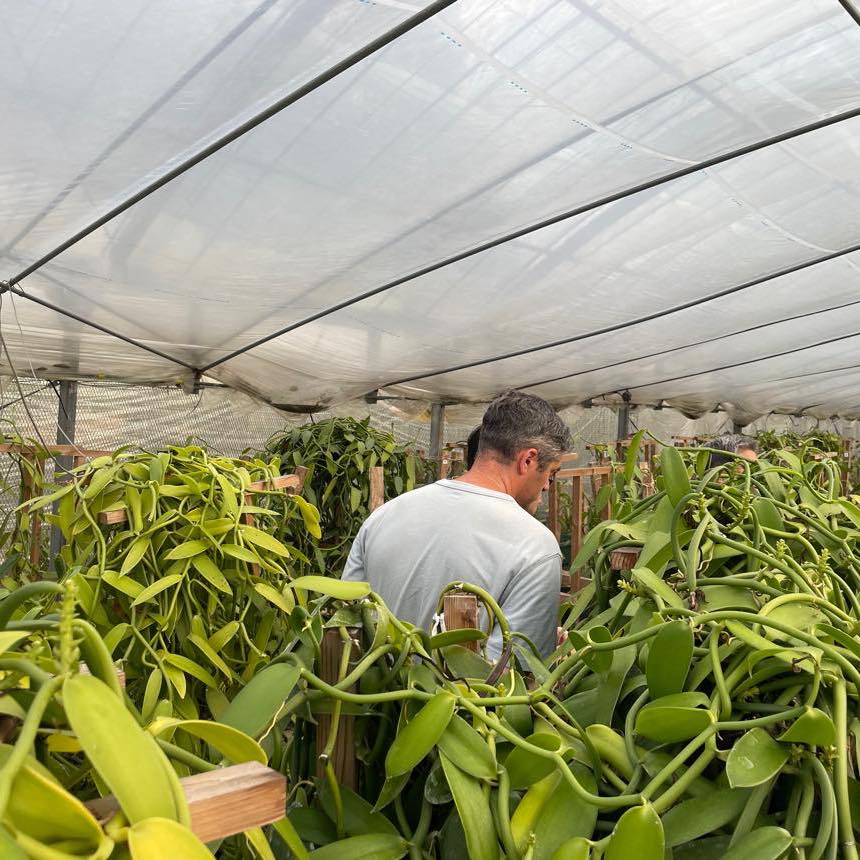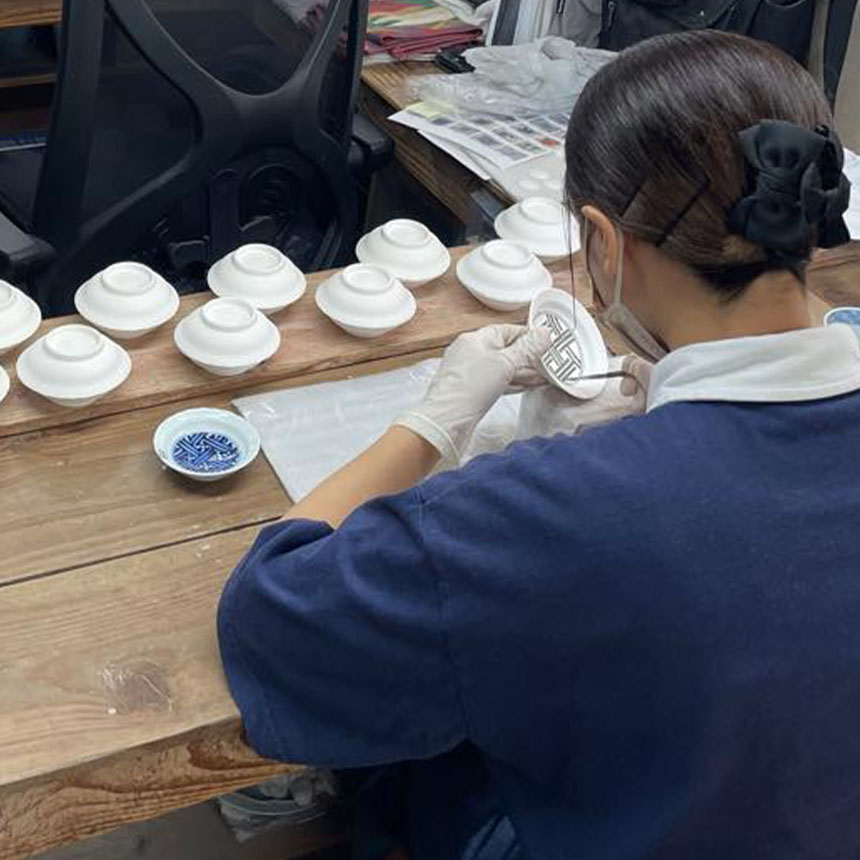Discovering Japan – Kyushu
Greeting from the culinary team. I’m Takuya Ozawa, Executive Sous Chef at Park Hyatt Tokyo. At the end of July, with Executive Chef Thibault Chiumenti and other team members, I took a trip to Kyushu to meet with farmers, fishers, producers and artisans.
Day 1: Kumamoto, Amakusa
Amakusa Prawns
Miyagawa was the first place in Japan to cultivate tiger prawns in 1905 and has been cultivating them in the waters around Amakusa for about 100 years. Kumamoto Amakusa is one of the largest producers of tiger prawns in Japan, with an annual production of approximately 70 tons compared to about 40 tons in Okinawa. It is also designated as the prefectural fish of Kumamoto.
The Amakusa prawn, a local tiger prawn, is characterized by its thick, sweet, and tender flesh. The young prawns are released into the sea, where they grow to a large size in three to four months and stop moving when the weather gets cold. When we visited in July, the prawns were being farmed just in time for the year-end season. We were impressed by the farm, which maintains an efficient production system through innovative aquaculture techniques, while taking advantage of the mineral-rich Amakusa sea: “The Sea of Treasures.”
Fukuda Fruit & Vegetables Farm
Our next stop was Fukuda Farm, a 30-minutes drive from Amakusa City. The owner, Mr Fukuda, has a strong desire to grow delicious fruits and vegetables that make people feel good after eating them. His own experiences have led him to commit to pesticide-free, organic and natural farming practices. He grows about 100 varieties of seasonal fruit and vegetables throughout the year. His cultivation methods, care for the environment, and uncompromising quality-control stand out, and we strongly felt his team’s passion and high aspirations.


Tobase Labo
On the island of Tobase in Uki, Kumamoto, Tobase Labo is taking on the challenge of growing vanilla beans and creating a new speciality products in its hometown. Mr. Nakagawa, the representative of the farm who is also an orchid farmer in his free time, also grows healthy and tasty avocados and passion fruit on the island, with the aim of “doing what no one else can do.” The Park Hyatt Tokyo team was inspired by his words about community development to promote the appeal of Tobase Island.


Amakusa Daioh
We also visited a breeding farm of the Amakusa Daioh, a fantastic local chicken that was once on the verge of extinction, but has since been revived over the last few years. Although we are used to seeing poultry in our profession, we were overwhelmed by the size of the birds which stand 90 cm tall and can weigh up to 7 kg. The Amakusa Daioh, which is characterised by the firm texture of its flesh and juicy taste, is raised in the magnificent nature of Aso, with carefully selected feed and mineral-rich underground water from Mount Aso.

Kikuka Winery
Kikuka Winery was established in Kikuka-cho, Yamaga, a major wine grape-growing region, with the aim of producing more locally-oriented wine. It currently grows a total of seven varieties of grapes, five for red wine and two for white wine. We were motivated by the lively and energetic work of their team.
Riso Porcelain
Riso Porcelain was established on the site of the residence of Lee Cam Pung, the founder of Arita Ware Porcelain. Under the motto “beautiful things bring happiness”, the pottery pursues a timeless aesthetic, while making full use of traditions and techniques. We observed the production process of moulding, glazing, painting and firing. The hardwork, dedication and focus of each craftsman.


Nabeshima Fukuchiyo Shuzo, a brewery located in a breathtaking location facing the Ariake Sea, was founded in 1923. The Nabeshima label was created in 1998 by Naoki Iimori, the third-generation owner of the brewery, who was seeking to create a unique sake using carefully selected rice and water. We were given a tour of the brewery, which is registered as a tangible cultural property. Experiencing the aroma of sake being brewed before our eyes was unforgettable.


Day 3: Fukuoka
Fukuoka City Central Wholesale Fish Market
The fresh fish market where auctions begin at 3:00 am (the earliest in Japan), is located right next to Hakata Fishing Port. It is one of the largest fish markets in Japan where fresh seafood from the Genkai Sea, the Sea of Japan, the East China Sea and other areas of Kyushu and western Japan is handled. Around 300 different types of fish come through each year. Fish from the Genkai Sea is plentiful. The market is full of people, and is the symbolic kitchen of Hakata, which supports Fukuoka, a city known for its seafood dishes. Last but not least, a special thank you to the people at Akira Suisan, who handle the highest volume of fish in the wholesale industry. We were greatly appreciative for their hard work and assistance.


Miyake Farm
Hakata Wagyu is the pride of Kyushu , a brand of beef which is carefully raised for about 20 months by only registered farmers in Fukuoka. Miyake Farm, which set up a ‘producers association’ more than a decade ago and led the creation of standards and practices for branded beef in Fukuoka, is a pioneer in this field.
A key feature is its feed. The cattle live off high-quality feed with rice straw from Fukuoka Prefecture as their primary staple, and Miyake Farm, which we visited, is both a livestock farmer and a rice farmer. They deliver quality and safety through sustainable, recycling-oriented agriculture practices, where rice straw is fed to cattle and cattle manure is then used on rice paddies. To minimize the stress of the cattle, nose chains are not used and music is played on the farm.
Miyake Farm’s Hakata Wagyu beef was awarded gold in 2011 at the Kyushu Regional Lineage Wagyu Beef Brisket Co-op Competition, which was the first time a farm won from Fukuoka. In 2017, Hakata Wagyu beef, which won the first prize at the Wagyu Olynpic.

Hakata Toyomitsuhime
Hakata Toyomitsuhime is a premium fig brand grown only by a limited number of farmers in Fukuoka Prefecture. It is a rare variety not widely available, produced in Toyomae and named ‘Toyomitsuhime’ because it’s as sweet as honey, and as delicate as a princess (in Japanese mitsu means honey and hime means princess). The average sugar content of the figs is much higher than usual, and the harvest season is said to be extremely busy as the figs are handpicked, one-by-one based on their ripeness.


Cosmo Farm
Cosmo Farm is headquartered in the northern part of Kurume City. We visited after it had rained, but the air around the farm was still fresh thanks to the rice paddies nearby which abrosb some of the humidity. The farm grows multiple variety of salad leaves and vegetables throughout the year by alternating production between Fukuoka and Hokkaido, believing that that people should have access to tasty and healthy vegetables all year round.
During our visit, they talked about the cultivation of mixed salad leaves which are grown in soil rather than hydroponics and harvested in less than a month. Each mix of baby leaves contains a blend of five to seven different vegetables, including mizuna, komatsuna, rocket, beetroot, taassai, red oak, red leaf and red lias mustard greens. The taste was delicate with a pleasant bitterness.

During this visit to Kyushu, we were able to experience the passion of the farmers, fishers and producers of each region, and we were hugely inspired. We will use this enriching experience as food for inspiration as we work together with those farmers and producers towards the re-opening of Park Hyatt Tokyo.